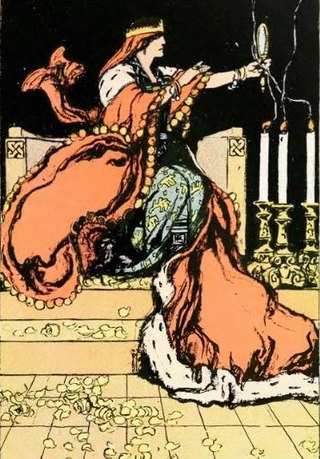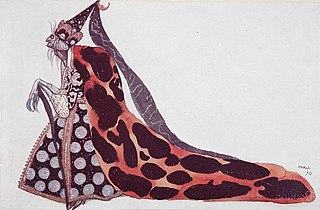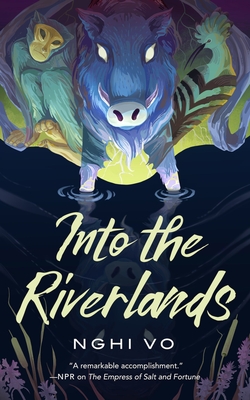
"Snow White" is a German fairy tale, first written down in the early 19th century. The Brothers Grimm published it in 1812 in the first edition of their collection Grimms' Fairy Tales, numbered as Tale 53. The original German title was Sneewittchen; the modern spelling is Schneewittchen. The Grimms completed their final revision of the story in 1854, which can be found in the 1857 version of Grimms' Fairy Tales.

"Sleeping Beauty", also titled in English as The Sleeping Beauty in the Woods, is a fairy tale about a princess cursed by an evil fairy to sleep for a hundred years before being awakened by a handsome prince. A good fairy, knowing the princess would be frightened if alone when she wakes, uses her wand to put every living person and animal in the palace and forest asleep, to awaken when the princess does.

Maleficent is a fictional character who first appears in Walt Disney Productions' animated film, Sleeping Beauty (1959). Maleficent is the self-proclaimed "Mistress of All Evil" based on the evil fairy godmother character in Charles Perrault's fairy tale Sleeping Beauty, as well as the villainess who appears in the Brothers Grimm's retelling of the story, Little Briar Rose. Maleficent was originally animated by Marc Davis.

The Evil Queen, also called the Wicked Queen or the Queen, is a fictional character and the main antagonist of "Snow White", a German fairy tale recorded by the Brothers Grimm. The most popular adaptation of the Evil Queen is from Disney's SnowWhite. The character has also become an archetype that has inspired unrelated works.

In fairy tales, a fairy godmother is a fairy with magical powers who acts as a mentor or parent to someone, in the role that an actual godparent was expected to play in many societies. In Perrault's "Cinderella", he concludes the tale with the moral that no personal advantages will suffice without proper connections.
Prince Charming is a fairy tale stock character who comes to the rescue of a damsel in distress and must engage in a quest to liberate her from an evil spell. This classification suits most heroes of a number of traditional folk tales, including "Snow White", "Sleeping Beauty", "Rapunzel" and "Cinderella", even if in the original story they were given another name, or no name at all.

Sleeping Beauty is a 1959 American animated musical fantasy film produced by Walt Disney Productions and released by Buena Vista Distribution. Based on Charles Perrault's 1697 fairy tale, the production was supervised by Clyde Geronimi, and was directed by Wolfgang Reitherman, Eric Larson, and Les Clark. Featuring the voices of Mary Costa, Bill Shirley, Eleanor Audley, Verna Felton, Barbara Luddy, Barbara Jo Allen, Taylor Holmes, and Bill Thompson, the film follows Princess Aurora, who was cursed by the evil fairy Maleficent to die from pricking her finger on the spindle of a spinning wheel. She is saved by three good fairies, who alter Aurora's curse so that she falls into a deep sleep and will be awakened by true love's kiss.

Jonathan Strahan is an editor and publisher of science fiction, fantasy, and horror. His family moved to Perth, Western Australia in 1968, and he graduated from the University of Western Australia with a Bachelor of Arts in 1986.

Spindle's End is a retelling of Sleeping Beauty by author Robin McKinley, published in 2000.

The Wicked fairy is the antagonist of Sleeping Beauty. In some adaptations, she is known as Carabosse. The most notable adaptation of the character is Maleficent, a Disney villain who appeared in various Disney media, beginning with the 1959 Walt Disney film Sleeping Beauty.
Sun, Moon, and Talia is an Italian literary fairy tale written by Giambattista Basile and published posthumously in the last volume of his 1634-36 work, the Pentamerone. Charles Perrault retold this fairy tale in 1697 as Sleeping Beauty, as did the Brothers Grimm in 1812 as Little Briar Rose.

Aurora, also known as Sleeping Beauty or Briar Rose, is a fictional character who appears in Walt Disney Productions' animated film Sleeping Beauty (1959). Originally voiced by singer Mary Costa, Aurora is the only child of King Stefan and Queen Leah. An evil fairy named Maleficent seeks revenge for not being invited to Aurora's christening and curses the newborn princess, foretelling that she will prick her finger on a spinning wheel's spindle and die before sunset on her sixteenth birthday. Merryweather, one of the three good fairies, weakened the curse so Aurora would only sleep. Determined to prevent this, three good fairies raise Aurora as a peasant in order to protect her, patiently awaiting her sixteenth birthday—the day the spell can only be broken by a kiss from her true love, Prince Phillip.

Sleeping Beauty is a 1987 American/Israeli fantasy film, part of the 1980 film series Cannon Movie Tales. It is directed by David Irving and stars Tahnee Welch, Morgan Fairchild, Nicholas Clay and Sylvia Miles. It is a contemporary version of the classic tale of Sleeping Beauty of the Brothers Grimm and Charles Perrault. Like the other Cannon Movie Tales, the film was filmed entirely in Israel.
The New Adventures of Snow White is a 1969 West German sex comedy film directed by Rolf Thiele and starring Marie Liljedahl, Eva Reuber-Staier, and Ingrid van Bergen. The film puts an erotic spin on three classic fairy tales Snow White, Cinderella and Sleeping Beauty. It exemplified the downturn in the career of Thiele who earlier in the decade had still been a mainstream director, but increasingly found himself making lower-budget sex comedies.

The Adventures of Doctor Eszterhazy is a collection of historical mystery fantasy short stories by Avram Davidson featuring his scholarly detective character Doctor Eszterhazy and set in an imaginary European country. It was first published in hardcover by Owlswick Press in January 1991, with an ebook edition issued by Gateway/Orion in August 2013. The book is an expansion of the earlier collection The Enquiries of Doctor Eszterhazy (1975), adding five more stories written later but set earlier; the only Eszterhazy story it left uncollected was 1988's "The Odd Old Bird."
Alix E. Harrow is an American science fiction and fantasy writer. Her short fiction work "A Witch's Guide to Escape: A Practical Compendium of Portal Fantasies" has been nominated for the Nebula Award, World Fantasy Award, and Locus Award, and in 2019 won a Hugo Award. Her debut novel, The Ten Thousand Doors of January (2019), was widely acclaimed by mainstream critics, lauded by general audiences during voting at Goodreads Choice Awards and Locus Awards, and nominated for multiple first novel literary awards and speculative fiction awards. She has also published under the name Alix Heintzman.

The Four Profound Weaves is an acclaimed 2020 LGBT+ fantasy novella by R. B. Lemberg. In 2021, it has been nominated in the best novella category for the Ignyte, Nebula, World Fantasy, and Locus awards.

The Bruising of Qilwa is a 2022 fantasy novella by Naseem Jamnia, the author's debut work. The plot centers on a non-binary refugee healer who practices blood magic and discovers a mysterious illness in their new city. The work was a finalist for the 2023 Locus Award for Best First Novel.

Thornhedge is a 2023 novella by Ursula Vernon, writing under the pen name T. Kingfisher. The novella is a reimagining of the story of Sleeping Beauty. It won the 2024 Hugo Award for Best Novella and 2024 Locus Award for Best Novella.

Into the Riverlands is a 2022 fantasy novella by Nghi Vo. It is the third published entry in the Singing Hills Cycle. Each novella can serve as an entry point to the series or as a standalone tale.
















